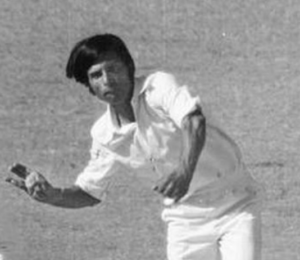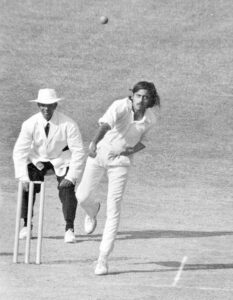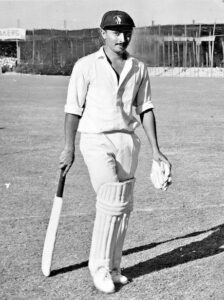Registered with the Registrar of Newspapers for India under R.N.I 53640/91
Vol. XXXI No. 9, August 16-31, 2021
Ranji Trophy final 1967-1968
by Ramnarayan V
When Madras fought back – and so did Bombay
The splendid rearguard action by Deepak Chahar and Bhuvneshwar Kumar in the recent India-Sri Lanka ODI series in Sri Lanka took one’s mind back to similar acts of heroism in the past, though mostly in the longer form of the game, and not always resulting in success for the fighting tail-enders’ teams. First among such partnerships I watched live at the stadium was an annoying 87-run stand between the Australian captain Ian Johnson (73) and Pat Crawford (34) for the ninth wicket after Vinoo Mankad (4 wickets), Subhash Gupte (3) and Ghulam Ahmed (2) had reduced the visiting Australians to 200 for 8 on the first morning of the first Test of the 1956-57 series at the Corporation Stadium, Madras. Australia eventually made 319, enough to ensure them an easy win. The only frontline batsmen to have scored that day had been young Ian Craig (40) and senior pro Neil Harvey (37 with nine fours), a slice of history about 200 admirers, including yours truly, reminded him of, soon after he dedicated the IIT-Sanmar cricket pavilion on a visit to Chennai in 1998. Another remarkable factoid of that long ago Test was that leg-spinner Richie Benaud, with seven scalps in the first Indian innings, and fast bowler Ray Lindwall, with seven in the second, were involved in a strange role reversal from the norm that bowled Australia to a convincing win.
There have been a few such Indian fightbacks in my own memory. Pankaj ‘Nana” Joshi (52) and Ramakant Desai (85) put on 149 for the ninth wicket in the Bombay Test against Pakistan in the 1960-61 series, the match ending in a draw, and in more recent years, Anil Kumble and Harbhajan Singh have made Test hundreds late in the batting order, contributing to remarkable comebacks.

V.V. Kumar
One of the most exciting matches I recall from the rich history of Ranji Trophy cricket was the 1967-68 final of the championship between Madras and Bombay which produced gallant rearguard actions by both sides, with fast bowlers C.K. Bhaskar and R. Prabhakar as well as spinners V.V. Kumar and S. Venkataraghavan doing Madras proud with both bat and ball.
The brief scorecard of the match hardly gives us any idea of the dramatic twists and turns of the match. Here it is:

Padmakar Shivalkar – who bowled exceptionally well from Bombay’s side. Courtesy: The Hindu.
Madras 258 (Najam Hussain 38, R. Prabhakar 67, C.K. Bhaskar 76 not out, Arun Varde 4 for 45, Subhash Gupte 3 for 59, P.K. Shivalkar 2 for 64) and 302 (*P.K. Belliappa 51, K.R. Rajagopal 73, Michael Dalvi 51, S. Venkataraghavan 34, V. Balaji Rao 43, Shivalkar 3 for 86, Gupte 3 for 128 )
Bombay 312 (Ashok Mankad 112, *Manohar Hardikar 73, V.R. Karkhanis 53, Bhaskar 4 for 68, Venkataraghavan 2 for 72, V.V. Kumar 2 for 52) and 225 for 5 (M.L. Apte 38, Karkhanis 43, Hardikar 65 not out, E.D. Solkar 55 not out, Venkataraghavan 2 for 85, Kumar 2 for 81)
Match drawn, but Bombay won by virtue of the first innings lead and retained the Ranji Trophy.

S. Venkatraghavan. Courtesy: The Hindu.
It was one of Tamil Nadu’s finest performances in the tournament, which it has won only twice in its history. Though I followed the game only long distance, through the AIR running commentary and The Hindu, I knew many of the cast of characters. I realised when the editor asked me to do this story that some of the dramatis personae are still around, and, in fact, just a phone call away. Prabhakar, the first player I called, was my First Form classmate at PS High School, circa 1957, and was soon to become one of the legends of the game in Mylapore and elsewhere with his six-hitting ability at a time the game was generally known for gentle nudges and lazy singles. While I got into the school’s junior team largely on account of the clout my elder cousin Ramachandran of the senior team wielded with the selection committee, it was some years before Prabhakar began to set the Cooum on fire with his swashbuckling ways, but once he arrived on the scene, his batting and in-swing bowling for State Bank of India drew delirious crowds to MCA (later TNCA) league and Hindu Trophy matches. Many feel that Prabhakar was treated shabbily by the selectors, but he himself never complains.
I lost contact with Prabhakar after I moved to Hyderabad in 1971, but played on and off against him in the Chennai league in the 1980s. My very last match in the senior league – against State Bank – left me, 40 years old and unfit, totally dehydrated in the blazing heat of May. I was so badly cramped that I could not move from my perch in the dressing room for two hours, with no facilities, no first aid, but Prabhakar stayed with me long after everyone else had left for the day. He was a strong, silent angel that afternoon.
The second veteran I called was V.V. Kumar the great leg spinner who was distinctly unlucky to play only two Test matches despite a brilliant debut. He was also my senior in State Bank of India, and my teammate in tournaments like the Moin-ud-Dowlah Gold Cup. He has been a mentor and steadfast supporter through the decades, even releasing my cricket memoirs in 2015.
I also spoke to A.G. Satvinder Singh, the youngest of three brothers to have served Madras-Tamil Nadu cricket with distinction, and the only one of them unlucky to miss playing for India – mainly because of a knee injury sustained in a road accident. As a teenager at a bus stop, I would wait for him to go to his college in the opposite direction on his scooter so that we could wave to each other. Little did I imagine we would actually play against, and with, each other.. Memorable were two fantastic partnerships we shared separated by more than a decade. In both of them, I was the sleeping partner, while Satvinder made 130-something and 93.

P.K. Belliappa. Courtesy: The Hindu.
In the Ranji Trophy final at the Brabourne Stadium in early 1968, Madras, captained by P.K. Belliappa, was tottering at 109 for 8, when no.9 Prabhakar’s new ball partner, the handsome, Kerala-born medical student C.K. Bhaskar, joined him at the crease. The two of them went on in their own merry way to plunder runs off the awe-inspiring attack of Subhash Gupte, Paddy Shivalkar and Arun Varde who had reduced Madras to a sorry state before the two pacemen came together. They put on 87 before Prabhakar was dismissed for 67. Bhaskar, who continued to score freely, remained not out on 76, adding 64 invaluable runs for the last wicket with the solid support of V.V. Kumar, one of the world’s great spinners, but not known for his batting skills. The Madras innings ended on a very respectable 258. Bombay made 312 in their first innings, with young Ashok Mankad making a superb 112, and the skipper Manohar Hardikar (73) and VR Karkhanis (53) making solid contributions against a splendid Madras attack, which had the spin twins Kumar and Venkataraghavan bowling immaculately as ever, but this time enjoying excellent lead contributions from Bhaskar and Prabhakar. Bhaskar’s 4-wicket haul was made possible by accurate and intelligent use of the seamer-friendly conditions on offer. (I was lucky to count Bhaskar as more than a fleeting acquaintance in inter collegiate cricket where I faced his impressive pace while playing for Presidency College against Madras (or Stanley) Medical College, and enjoyed his easy camaraderie off the field. Emigrating to Canada, he became a successful and highly respected surgeon there. He passed away a couple of years ago, much mourned by a large community of admirers from all walks of life). The Madras batting came into its own in the second innings, with skipper Belliappa and K.R. Rajagopal putting on 121 for the opening wicket in characteristically brisk style, with Raja blazing away on twinkling toes as was his wont, and the late Belli quieter by comparison. The brilliant Michael Dalvi – who played with distinction for Bengal after a long stint for Madras-TN, and whose father Brigadier Dalvi authored the book Himalayan Blunder on the Sino-Indian war of 1962, Venkataraghavan and Balaji Rao all pulled their weight helping Madras to a fighting second innings total. Bombay needed 246 to win the match in more than a whole day’s play, but only needed to draw the game to clinch the match and title on the basis of their first innings lead. A heroic bowling performance by the spinners Kumar and Venkataraghavan after a good start meant that Bombay were in dire straits at 109 for five, but Hardikar and teenager Eknath Solkar played through two entire sessions to draw the match.
Prabhakar is quietly proud of the roles he and Bhaskar played in the match. “What was the conversation between you and Bhaskar like?” I asked my old classmate. “We hardly spoke. I think we just played our natural game, playing each ball on its merit. You know we both batted high in the order back home, but the Bombay bowlers didn’t know that.” V.V. Kumar praised the two all rounders for both their bowling and their batting. “They used the conditions very well to trouble top class batsmen like Madhav Apte.” 87-year old Kumar, who drives more than fifty kilometres a day ferrying his grandson to and fro his football coaching camp, still feels guilty about that long-ago miss. “We should have won the match,” he rues. Both he and Satvinder Singh recall some horrific umpiring blunders that perhaps cost Madras the match that day. One of them was a clean catch above ankle height at midwicket by Satvinder, with umpire Shambhu Pan somehow missing it altogether. There were a couple of dropped catches too at crucial moments. Satvinder recalls that he and Michael Dalvi repeatedly called one of the Bombay batsmen “Karkhanis the Second” after he survived a clear caught-behind-the wicket appeal.
Tamil Nadu (now renamed) met Bombay again in the Ranji final six years later, and this time, Bombay won outright. That is a story for another day, but the 1967-68 final will go down as one of the great contests of domestic cricket.


Is the former England Captain Nasser Hussain and his father Raza Jawad Hussain who played one Ranji Trophy for Madras in 1964-65 related to the Madras player Najam Hussain ?
Really a fantastic match. I heard commentary and felt tense when Madras lost 8 wkts and when CKB R Prabhakar revived rhe innings I felt comfortable. We should have won the match.